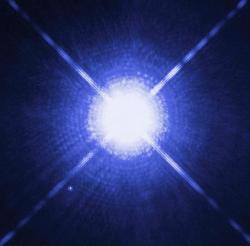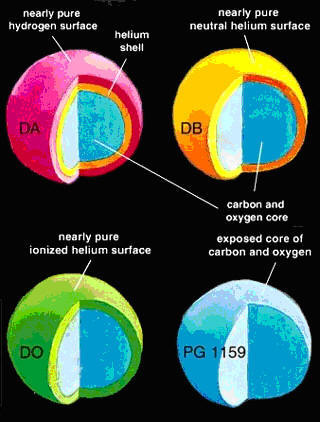white dwarf

The white dwarf Sirius B appears as a dot on the lower left portion of this Hubble image. It orbits its bright companion, Sirius, every 50 years. Image: NASA/HE Bond/E Nelan/M Barstow/M Burleigh/JB Holberg/STScI/U Leicester/U Ariz.

Internal structure of various white dwarf types.
A white dwarf is a dim, dense, planet-sized star that marks the evolutionary endpoint for all but the most massive stars (see stars, evolution). The first white dwarf to be discovered, in 1862, and the closest to the Sun, is the companion of Sirius.
White dwarfs form from the collapse of stellar cores in which nuclear fusion has stopped, and are exposed to space following the loss of the old star's bloated outer envelope, typically as a planetary nebula. They consist of electron degenerate matter, which provides the pressure needed to prevent further collapse, providing that the mass of the dwarf doesn't exceed the Chandrasekhar limit of about 1.4 solar masses.
Even a fairly large white dwarf, with a mass similar to that of the Sun, is only about as big as Earth. A piece of it the size of a sugar cube would weigh about as the same as a hippopotamus.
Types of white dwarf
Lighter mass stars that never get around to burning carbon in their cores give rise to carbon-oxygen white dwarfs, while stars that start out with a mass of at least 4 solar masses may give rise to neon-oxygen dwarfs. In addition, white dwarfs differ in terms of their spectra which are dictated by the elements that dominate their surfaces. Three varieties – dA, dB and dO (where "d" stands for "degenerate") – have nearly pure surfaces of hydrogen or helium lying atop their cores, whereas PG 1159 stars appear to be partially exposed cores. White dwarfs may also have a mixture of elements on their surfaces, and are named accordingly. For example, dAB stars contain hydrogen and neutral helium, whereas dAO stars have hydrogen and ionized helium.
| Spectral classification of white dwarfs | |
|---|---|
| type | characteristics |
| dA | Only Balmer lines: no HeI or metals present |
| dB | HeI lines: no H or metals present |
| dC | Continuous spectrum, few or no lines visible |
| dO | HeII strong: HeI or H present |
| dZ | Metal lines only: no H or He lines |
| dQ | Carbon features, either atomic or molecular in any part of the spectrum |
ZZ Ceti star
A ZZ Ceti star is a white dwarf that is also a pulsating variable and changes in brightness by 0.001 to 0.2 magnitude over a period of 30 seconds to 25 minutes. Non-radial pulsations are involved with multiple periodicities, which result in only slight changes in the star's size but significant fluctuations in temperature. There are three subtypes: ZZA with DA (hydrogen absorption) spectra, ZZB with DB (helium absorption spectra), and ZZO, sometimes called GW Virginis stars, with extremely hot, DO spectra. Sometimes flares of about one magnitude are observed, but these may be due to UV Ceti type companion stars.
White dwarfs and supernovae
White dwarfs that consume matter from their companions can explode as type 1a supernovae, which are used as standard candles to measure cosmic distances. In 1988, these supernovae provided the evidence for the accelerating expansion of the universe when they were found to be dimmer than expected.
Lightest white dwarf
 |
| Artist's impression of SDSS J091709.55+463821.8.
Credit: David A. Aguilar (CfA)
|
The lowest-mass white dwarf known is SDSS J091709.55+463821.8, with only 17% the mass of the Sun. It lies 7,400 light-years away near the border of the constellations Lynx and Ursa Major. Its discovery was announced in 2007 by a team of American astronomers.
SDSS J091709.55+463821.8 is a member of a binary star system and has evidently lost much of its matter in the past to a companion star, which also appears to be a white dwarf. The two now orbit each other every 7.6 hours at a distance of about 1,040,000 kilometers and with a speed of 536,000 kilometers per hour.
Life around white dwarfs
Could life exist on any planets around white dwarfs? This possibility is considered in a study, published in 2012 by Luca Fossati at the Open University in the UK and his colleagues, which suggests that an Earth-like planet in a white dwarf's habitable zone would receive enough light at the right wavelengths to sustain photosynthesis.1 At the same time, the team's simulations showed, such a planet would not be sterilized by harsh ultraviolet bombardment – receiving less than double the dose of UV experienced at the Earth's surface.
Other astrobiological advantages of white dwarfs are their stability and longevity. They're not prone to the kind of unpredictable and violent activity, including superflares, often demonstrated by red dwarfs, and they should be able to sustain a habitable zone around themselves for about 8 billion yr, or almost twice the present age of Earth.
The biggest question mark hanging over white dwarfs, as regards their ability to nurture life, is whether they ever retain intact Earth- or super-Earth-sized planets in suitable orbits. No planets have yet been detected around white dwarfs, and it's unclear whether a rocky world could remain intact or in an orbit within the habitable zone given the trauma that a star goes through on its way to becoming a white dwarf, including the ejection of a planetary nebula.
Reference
1. Fossati, L., Bagnulo, S., Haswell, C. A., Patel, M. R., Busuttil, R., Kowalski, P. M., Shulyak, D. V., and Sterzik, M. F. "The habitability and detection of Earth-like planets orbiting cool white dwarfs." Accepted for publication in ApJ Letters.

